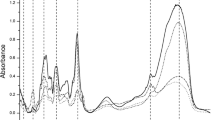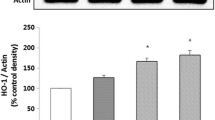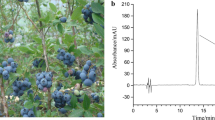Abstract
Tributyltin (TBT) is a biocide extremely toxic to a wide range of organisms, which has been used for decades for industrial purposes. Fucoxanthin is a natural carotenoid that is isolated from seaweed, and fucoxanthinol is a major primary metabolite of fucoxanthin. Although fucoxanthin and fucoxanthinol have been reported to possess anti-oxidant activities in vitro, little is known as to whether they protect against TBT-induced oxidative stress in cultured cells. In the present study, the protective effect of fucoxanthin and fucoxanthinol against oxidative stress induced by TBT was investigated. The data showed that incubation of HepG2 cells with 0.2 μM TBT significantly increased cell apoptosis, whereas treatment with fucoxanthin or fucoxanthinol (3 μM) significantly recovered cell viability. In addition, fucoxanthinol treatment significantly decreased the intracellular reactive oxygen species (ROS) and malondialdehyde (MDA) in HepG2 cells incubated with TBT. Moreover, fucoxanthin and fucoxanthinol markedly increased the expression level of Bcl-2/Bax. These results demonstrated that both fucoxanthin and fucoxanthinol effectively prevented cytotoxicity in HepG2 cells treated with TBT, and the protective effect was likely associated with decreased intracellular ROS and MDA and increased Bcl-2/Bax levels.






Similar content being viewed by others
References
An MI, An KW, Choi CY (2009) Changes in antioxidant enzyme activity and physiological responses to cadmium and tributyltin exposure in the ark shell, Scapharca broughtonii. Mol Cell Toxicology 5:273–282
Bernat P, Gajewska E, Szewczyk R, Slaba M, Dlugonski J (2014) Tributyltin (TBT) induces oxidative stress and modifies lipid profile in the filamentous fungus Cunninghamella elegans. Environ Sci Pollut Res 21:4228–4235
Choi MS, Kwon SR, Choi SH, Kwon HC (2012) Effect of TBT and PAHs on CYP1A, AhR and vitellogenin gene expression in the Japanese eel, Anguilla japonica. Dev Reprod 16:289–294
Choi JH, Kim NH, Kim SJ, Lee HJ, Kim S (2015) Fucoxanthin inhibits the inflammation response in paw edema model through suppressing MAPKs, Akt, and NFκB. J Biochem Mol Toxicol 30:111–119
Coutinho JV, Freitas-Lima LC, Freitas FF, Freitas FP, Podratz PL, Magnago RP, Porto ML, Meyrelles SS, Vasquez EC, Brandao PA, Carneiro MT, Paiva-Melo FD, Miranda-Alves L, Silva IV, Gava AL, Graceli JB (2016) Tributyltin chloride induces renal dysfunction by inflammation and oxidative stress in female rats. Toxicol Lett 260:52–69
Fang LP, CH X, Li J, Borggaard O, Wang DS (2017) The importance of environmental factors and matrices in the adsorption, desorption, and toxicity of butyltins: a review. Environ Sci Pollut Res 24:9159–9173
Gao JM, Wu L, Chen YP, Zhou B, Guo JS, Zhang K, Ouyang WJ (2017) Spatiotemporal distribution and risk assessment of organotins in the surface water of the Three Gorges Reservoir Region, China. Chemosphere 171:405–414
Heo SJ, Jeon YJ (2009) Protective effect of fucoxanthin isolated from Sargassum siliquastrum on UV-B induced cell damage. J Photochem Photobiol B 95:101–107
Heo SJ, Ko SC, Kang SM, Kang HS, Kim JP, Kim SH, Lee KW, Cho MG, Jeon YJ (2008) Cytoprotective effect of fucoxanthin isolated from brown algae Sargassum siliquastrum against H2O2-induced cell damage. Eur Food Res Technol 228:145–151
Im E, Kim H, Kim J, Li H, Yang H (2015) Tributyltin acetate-induced immunotoxicity is related to inhibition of T cell development in the mouse thymus. Mol Cell Toxicol 11:231–239
Ishihara Y, Kawami T, Ishida A, Yamazaki T (2012) Tributyltin induces oxidative stress and neuronal injury by inhibiting glutathione S-transferase in rat organotypic hippocampal slice cultures. Neurochem Int 60:782–790
Kang MC, Lee SH, Lee WW, Kang N, Kim EA, Kim SY, Lee DH, Kim D, Jeon YJ (2014) Protective effect of fucoxanthin isolated from Ishige okamurae against high-glucose induced oxidative stress in human umbilical vein endothelial cells and zebrafish model. J Funct Foods 11:304–312
Kharbanda S, Pandey P, Schofield L, Israels S, Roncinske R, Yoshida K, Bharti A, Yuan ZM, Saxena S, Weichselbaum R, Nalin C, Kufe D (1997) Role for Bcl-xL as an inhibitor of cytosolic cytochrome C accumulation in DNA damage-induced apoptosis. Proc Natl Acad Sci 94:6939–6942
Kim NS, Shim WJ, Yim UH, Hong SH, Ha SY, Han GM, Shin KH (2014) Assessment of TBT and organic booster biocide contamination in seawater from coastal areas of South Korea. Mar Pollut Bull 78:201–208
Konishi I, Hosokawa M, Sashima T, Kobayashi H, Miyashita K (2006) Halocynthiaxanthin and fucoxanthinol isolated from Halocynthia roretzi induce apoptosis in human leukemia, breast and colon cancer cells. Comp Biochem Physiol Part C Pharmacol Toxicol 142:53–59
Kumar SR, Narayan B, Kizawa Y, Kizawa y HM (2016) Does squalene alter the antioxidant potential of astaxanthin and fucoxanthinol? In vitro evidence in RAW 264.7 cells, a murine macrophage. J Food Sci Technol 53:2139–2143
Li ZH, Zhong LQ, WN M, YH W (2015) Toxicity of tributyltin in juvenile common carp (Cyprinus Carpio): physiological responses, hepatic gene expression, and stress protein profiling. J Biochem Mol Toxicol 30:91–96
Lin JJ, Huang L, Yu J, Xiang SY, Wang JL, Zhang JR, Yan XJ, Cui W, He S, Wang QW (2016) Fucoxanthin, a marine carotenoid, reverses scopolamine-induced cognitive impairments in mice and inhibits acetylcholinesterase in vitro. Mar Drugs 14:67–83
Liu HG, Xu LH (2007) Garlic oil prevents tributyltin-induced oxidative damage in vivo and in vitro. J Food Prot 70:716–721
Liu HG, Wang Y, Lian L, LH X (2006) Tributyltin induces DNA damage as well as oxidative damage in rats. Environ Toxicol 21:166–171
Maeda H, Kanno S, Kodate M, Hosokawa M, Miyashita K (2015) Fucoxanthinol, metabolite of fucoxanthin, improves obesity-induced inflammation in adipocyte cells. Mar Drugs 13:4799–4813
Martin LJ (2015) Fucoxanthin and its metabolite fucoxanthinol in cancer prevention and treatment. Mar Drugs 13:4784–4798
Mitra S, Gera R, Siddiqui WA, Khandelwal S (2013) Tributyltin induces oxidative damage, inflammation and apoptosis via disturbance in blood-brain barrier and metal homeostasis in cerebral cortex of rat brain: an in vivo and in vitro study. Toxicology 310:39–52
Omura M, Ogata R, Kubo K, Shimasaki Y, Aou S, Oshima Y, Tanaka A, Hirata M, Makita IN (2001) Two-generation reproductive toxicity study of tributyltin chloride in male rats. Toxicol Sci 64:224–232
Sangeetha RK, Bhaskar N, Baskaran V (2009) Comparative effects of beta-carotene and fucoxanthin on retinol deficiency induced oxidative stress in rats. Mol Cell Biochem 331:59–67
Shen H, Liu J, Wang Y, Lian H, Wang J, Xing L, Yan X, Wang J, Zhang X (2013) Aflatoxin G1-induced oxidative stress causes DNA damage and triggers apoptosis through MAPK signaling pathway in A549 cells. Food Chem Toxicol 62:661–669
Takahashi K, Hosokawa M, Kasajima H, Hatanaka K, Kudo K, Shimoyama N, Miyashita K (2015) Anticancer effects of fucoxanthin and fucoxanthinol on colorectal cancer cell lines and colorectal cancer tissues. Oncol Lett 10:1463–1467
Tan CP, Hou YH (2013) First evidence for the anti-inflammatory activity of fucoxanthin in high-fat-diet-induced obesity in mice and the antioxidant functions in PC12 cells. Inflammation 37:443–450
Xu XC, He LY, Zhang AM, Li Q, Hu w CH, Du J, Shen JL (2015) Toxoplasma gondii isolate with genotype Chinese 1 triggers trophoblast apoptosis through oxidative stress and mitochondrial dysfunction in mice. Exp Parasitol 154:51–61
Yue P, Leung H, Li A, Chan T, Lum T, Chung Y, Sung Y, Wong M, Leung K, Zeng E (2017) Angiosuppressive properties of marine-derived compounds: a mini review. Environ Sci Pollut Res 24:8990–9001
Zhang H, Tang YB, Zhang Y, Zhang SF, Qu J, Wang X, Kong R, Han CC, Liu ZQ (2015) Fucoxanthin: a promising medicinal and nutritional ingredient. Evid-Based Compl Alt 27:1–10
Zhang J, Sun P, Yang F, Kong T, Zhang R (2016) Tributyltin disrupts feeding and energy metabolism in the goldfish (Carassius auratus). Chemosphere 152:221–228
Acknowledgements
This research was supported by the Ocean Public Welfare Scientific Research Special Appropriation Project (201405017) and the Program for Xiamen Southern Oceanographic Center (14GST69NF33). Professor John Hodgkiss of the City University of Hong Kong is thanked for his help with English.
Author information
Authors and Affiliations
Corresponding authors
Ethics declarations
Conflict of interest
The authors declare that they have no conflict of interest.
Additional information
Responsible editor: Philippe Garrigues
Jie Zeng and Yiping Zhang are co-first authors.
Electronic supplementary material
FIGURE S1
(DOCX 50 kb)
Rights and permissions
About this article
Cite this article
Zeng, J., Zhang, Y., Ruan, J. et al. Protective effects of fucoxanthin and fucoxanthinol against tributyltin-induced oxidative stress in HepG2 cells. Environ Sci Pollut Res 25, 5582–5589 (2018). https://doi.org/10.1007/s11356-017-0661-3
Received:
Accepted:
Published:
Issue Date:
DOI: https://doi.org/10.1007/s11356-017-0661-3




